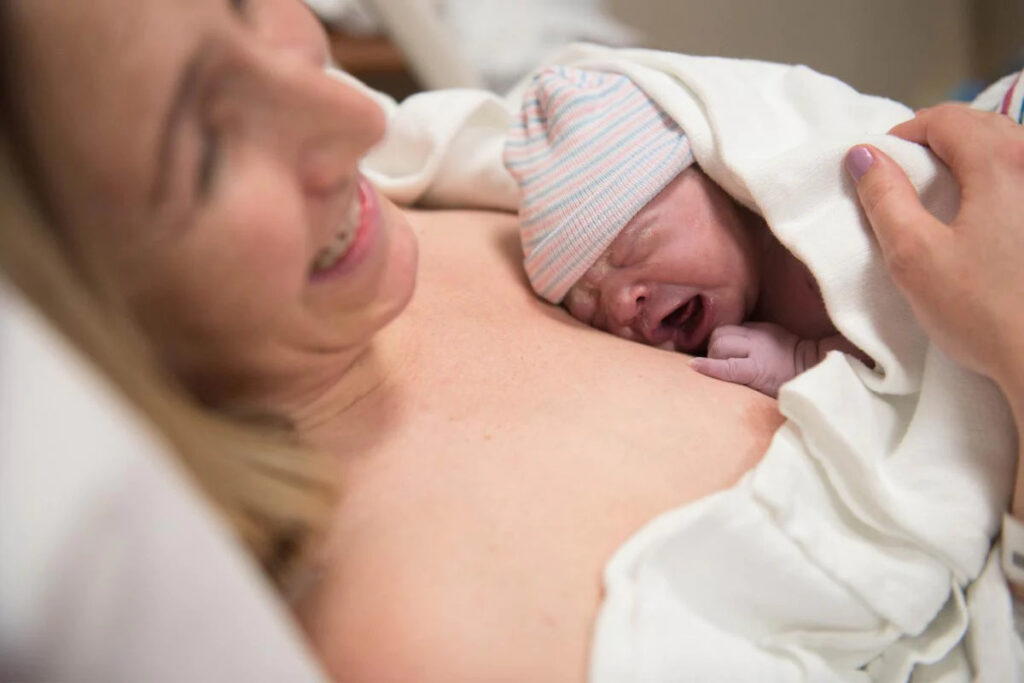The end of the third trimester of pregnancy is marked by the start of labor and the eventual delivery process. The labor process is often the most awaited yet highly feared stage of pregnancy. Let me take you through the labor process and tell you a bit about the delivery phase of my pregnancy journey.
The Labor Process
Labor is considered the end of your third trimester and your pregnancy. Labor means your baby is ready to meet the world, and so your uterus notifies you in the form of recurring pains. It is the process through which the baby comes out of your body and thus, it is the event of childbirth.
Labor, in other words, is the rhythmic flow of contractions that come and go in intervals. When your uterus and your baby are ready, your uterus will start to stretch and contract, which helps in pushing the baby out. This cycle of stretching and pushing is known as contractions. These contractions are usually painful.
Throughout the end of your third trimester, you will have false pains that are known as Braxton Hicks. These false pains allow you to encounter what contractions would feel like. These false pains do not mean you are in labor.

The major difference between Braxton Hicks and labor pain is that Braxton Hicks will happen during the end of the 8th month and throughout the ninth month, are not rhythmic, they will occur sporadically, and will be short, jabbing pains.
Whereas labor contractions happen at the end of the third trimester, they are rhythmic and will happen with intervals, for example, they will happen every hour, then every 20 minutes, and every 10 minutes, the intervals will shorten and the contractions will lengthen. Labor contractions could be like cramping pain in your tummy or a drumming pain in your back.
Labor contractions get stronger over time so if you are at the end of your pregnancy and feel these contractions, notice the timing and intervals, if they are frequent, it would be best to give your ob-gyn a call. Labor contractions usually cause the waterbag to burst and you could have a gush or trickle of water coming out. This is a sign that the baby is ready to meet you.
After the 37th week, your baby is considered ‘full term’ which means they are ready for the world and you can expect your labor pains to start naturally anytime between the 37th to 42nd week. Sometimes, you reach the end of your pregnancy and don’t feel any labor pain or show any signs of labor at all.
If this happens, your healthcare provider might suggest induction to you.
What Is Induction?
Induction is the process of inducing or starting labor if a woman has not shown any signs of natural labor and has reached the end of her pregnancy which is around 40 weeks. Your healthcare provider will talk to you about the possibility of induction if you are at the end, and will talk you through it before carrying on.
Induction is like assisting you to naturally start the labor process and give birth vaginally. There are a few different methods that are used to induce labor:
- Membrane sweeping – Your healthcare provider will insert gloved fingers inside your cervix to loosen the amniotic sac and help you start labor. This is usually done after 39 weeks.
- Hormones to ripen the cervix – Hormones are inserted inside to help ripen the cervix and start labor naturally.
- Hormones to stimulate labor – Your healthcare provider might give you some hormones intravenously through an IV, in order to start labor.
- Rupture the water bag – Your doctor might rupture the membranes of your amniotic sac so that your water breaks and stimulates labor.
If your labor does not start naturally, these methods will help to induce labor and dilate the cervix to help you with delivery. If you want to start labor naturally, you can try researching raspberry leaf tea which is an organic pregnancy tea that is great for stimulating labor. However, you should always check with your healthcare provider before consuming these.
Types of Delivery
Yes, there are different ways you can deliver a child, vaginally is just one type. Even vaginal deliveries have types (mindless, I know). There are a number of ways that you could choose to deliver your child.

Natural Delivery
Natural delivery is when you deliver a baby naturally (and of course, vaginally) but without any external assistance, such as induction. You start the labor process and contractions naturally and do not take the help of anesthesia such as an epidural and deliver the baby completely naturally.
We usually see in movies and shows that women give birth, lying down on a birthing chair and pushing aggressively with their legs propped up. That is one way you can give birth. However, not all women give birth this way, some also have a squatting birth or a water birth.
Vaginal Delivery
Vaginal delivery is also natural, to an extent. It means that you chose to give birth vaginally, but may have taken extra help in the form of induction of labor, or perhaps anesthesia such as epidural. You can opt for a squatting birth or water birth, but your healthcare provider will tell you what is best for you.
Assisted Vaginal Delivery
An assisted vaginal delivery is when you deliver your baby vaginally but some extra assistance is given such as using a vacuum or forceps to help pull the baby out. This usually happens if you have been in labor for too long if the labor is not progressing, or if you or the baby are showing signs of stress and fatigue.
Cesarean Birth (C-section)
A lot of times, there are complications in pregnancy, or you might not reach labor for some reason or the other, even after induction. If this happens, or if there are any other issues such as the vitals of the baby not being stable, etc… Your doctor might recommend going for a C-section.
A C-section is basically a surgery, in which your obstetrician will make surgical incisions on your abdomen and uterus and take the baby out through your abdomen. They will stitch you up after they have taken the baby out.
Vaginal Birth After Cesarean (VBAC)
The reason why VBAC is categorized as a separate type and not just called vaginal delivery is that many people are of the idea that if your first delivery was a C-section, then you cannot have a vaginal delivery, you could only deliver through C-section.
This is not entirely true. Yes, many people who have delivered via C-section in their first baby, might get another C-section but there are numerous women who have gone for VBAC and have delivered babies safely.
Post-Birth
Once you are set up for delivery, then it is just a matter of time, patience, and endurance till you get to see the mini-you that you faced so many ordeals for. In vaginal deliveries, once you give birth and are cleaned up, you are ready to meet your baby.

However, those who have had a C-section may be groggy due to the lingering anesthesia, but that too wears off in a few hours. Women who have had a C-section might have to follow a few different protocols than those who have had a vaginal delivery and your healthcare provider will fill you up on those details.
My Birthing Story
My firstborn’s birthing story was far more eventful than my second. During my firstborn’s time, I faced preterm labor pains, which occurred in my 8th month. My ob-gyn gave me necessary treatments and I was put on bed rest and I became better in no time.
I was given a due date which all women are given, it is the expected date of delivery of the baby. It isn’t set in stone so the baby could come earlier, or later than the date. However, it is around your due date that your baby’s birthday will happen.
So, I reached the end of my 9th month and nothing happened. I didn’t even feel Braxton Hicks that strongly, to be honest, and since it was my first experience, I had no idea what was happening. My 9th month came to a close with no labor pains in sight, I hadn’t even lost my mucus plug which is a usual sign that your cervix is ready.
So, as my due date came closer and the baby didn’t seem interested in coming out, my doctor recommended I go for induction. I agreed and so on the due date, I went and got admitted to the gynecology ward of the hospital so that I could be induced and get my labor stimulated.
The first thing the doctor did was a membrane sweep. Trust me, it is awful. I had read about it and people said it is uncomfortable and boy, were they downplaying their sentiments. It hurt. Downright hurt. Not to mention absolutely awkward to get it done.
Anyhow, the membrane sweep didn’t work and so they went ahead with hormonal gels that would stimulate labor. That didn’t work as well.
The third option was to get hormones through IV, which I agreed to. I just needed to get this going because I had been in the hospital for over 10 hours and it was just getting annoying.
Nothing really happened, I didn’t feel much pain, just slight discomfort. My ob-gyn then arrived and told me this was what they term ‘failed induction’. This means that the induction method wasn’t working.
I was already really tired due to the day’s ordeal and the baby inside started showing signs of stress, and due to a few other complications, my doctor suggested I go for a C-section. Much as I feared it, I went ahead, thinking I’d rather get stitches on my tummy than down there anyway.
My C-section went by in a blur, as I was given spinal anesthesia and so I didn’t really feel much. I was groggy throughout the whole episode but I knew something was happening, although there was no pain. I felt nothing. I was also void of emotions at the time, I remember praying and blabbering throughout the surgery.
The surgery went well and after being stitched up, I was taken to a recovery room and then transferred to a room where I met my partner and my baby boy. I still remember not being overwhelmed with emotions at the sight of my son, only because I was still under the effect of anesthesia.
But once that wore off, the motherly feelings came instinctively and the cuddles and kisses began.
When I conceived the second time, I discussed my delivery options with my doctor and I was suggested to go for VBAC but I conveniently went for an elective C-section.
An elective C-section is when you choose to get surgery rather than go for vaginal delivery.
So my second delivery went by in a blur as well, however, in my second, I feel I was more under control of myself because I knew what was going to happen and was mentally prepared for it. So, on the morning of my C-section, I went and got admitted. I was prepped for surgery and was back in less than an hour.
It was quite quick, I was in my room, still a bit groggy when I was handed my secondborn, a daughter this time, and once again, the motherly instincts kicked in. This time, quicker than the first.
Conclusion
The process of delivering a child, no matter which method you choose to go by, is difficult. Perhaps one of the most difficult things in the world. But do you know what’s even more difficult than giving birth? Raising a child.

To bring up a child and inculcate morals and ethics, to educate them, to feed them, and to teach them humanity is even more difficult than pushing a baby out of you. But guess what, I see women doing it since the beginning of time, till date, and till the last day.
And for that, women all around the world deserve a huge round of applause.
